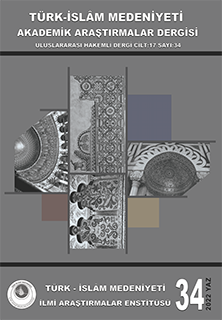Evaluation of Adaptation to the New Function by Spatial Analysis in Revitalization of Monumental Buildings; Sahabiye Madrasa of Kayseri
Keywords:
Protection, Reuse, Spatial analysis, Kayseri Sahabiye MadrasahAbstract
Since the lifestyle of societies change in time, which results in different needs and desires, monumental buildings lose their original functions. Preservation and continuous utilization of monumental buildings is possible if they are given new functions while their value and specific characteristics are preserved, where a balance is guaranteed between the new function and the original space. With the new form of utilization, it is critical for the ability of the space to respond to the needs of the new function, and for the continuity of the new function and thus sustainability of the building. In order for preservation to be sustainable, the building should be able to respond optimally to the needs of its new users and requirements of its new functions; thus the adaptation between the new function and the monumental building should be ensured. In order for identification of such adaptation level, the spatial and operational requirements of the new function should be set forth and an evaluation should be done on whether the monumental building is suitable for the new function. The evaluation results would provide data for the following practices and help selection of the new function. In this study, the adaptation level of the Sahabiye Madrasa of Kayseri, which is being reutilized under the name, “Book Bazaar”, to its new function is investigated with the spatial analysis method. The study suggests that, although the madrasa had an open patio and single-floor plan, its original plan, architectural composition and spatial characteristics of the madrasa were modified during its utilization as the Book Bazaar, and the interventions to the original spaces within the building damaged the historical identity, esthetics, documental value and authenticity of the building.
References
ALEMDAR, Y., Z., 2010, “Anlatıya Dayalı Bir Kent Okuması: Kayseri Sahabiye Medresesi”, Erciyes Üniversitesi, Sosyal Bilimler Enstitüsü Dergisi, Sayı: 29,
Yıl: 2010/2, s:283-306, http://sbe.erciyes.edu.tr/dergi/sayi_29/16.pdf (Erişim Mart 2012)
ANONİM, 2000, “In "Code of Ethics" - Canadian Association for Conservation of Cultural Property and the Canadian Association of Professional Conservators”, http://ip51.icomos.org/~fleblanc/documents/terminology/doc_terminolo gy_e.html (Erişim Ekim 2015)
ASLANAPA, O., 2007, “Anadolu’da İlk Türk Mimarisi Başlangıç ve Gelişimi”, Atatürk Yüksek Kurumu, Atatürk Kültür Merkezi Başkanlığı Yayını, Ankara.
AYDIN, D., YALDIZ, E., 2010, “Yeniden Kullanıma Adaptasyonda Bina Performansının Kullanıcılar Üzerinden Değerlendirilmesi”, METU-JFA, 27:1, S.1-22, Ankara.
http://jfa.arch.metu.edu.tr/archive/0258-5316/2010/cilt27/sayi_1/1-22.pdf (Erişim Nisan 2011)
CANTACUZINO, S., 1989, “Re/Achitecture; Old Buildings/New Uses”, Abbeville Pres, New York.
CANTELL, S. F., 2005. “The Adaptive Reuse of Historic Industrial Buildings: Regulation Barriers, Best Practices and Case Studies”, Virginia Polytechnic Institute and State University, Submitted in partial fulfillment of the requirement for the degree Master of Urban and Regional Planning. www.nvc.vt.edu/uap/docs/Student Projects/Cantell_Practicum.pdf (Erişim Nisan 2010)
DOUGLAS, J., 2006, “Building Adaptation”, Butterworth- Heinemann Elsevier, Edinburg.
EYÜCE, Ö., EYÜCE, A., 2010, “Design Education for Adaptive Reuse”,
International Journal of Architectural Research, Special Volume, Design Education: Explorations and Prospects for a Better Built Environment Volume (4) –Issues (2-3), s:419-428.
http://archnet.org/gws/IJAR/10541/files_10301/-ijar_vol%204_issues%2023_july_november_2010.pdf (Erişim Eylül 2011)
GABRIEL, A., 1934, “Monuments II” s:152-155, Paris.
KİPER, P., 2006, “Küreselleşme Sürecinde Kentlerin Tarihsel Kültürel Değerlerinin Korunması, Türkiye Bodrum Örneği”, Sosyal araştırmalar Vakfı Yayını, İstanbul.
KURAN, A., 1969, “Anadolu Medreseleri”, Cilt 1, Türk Tarih Kurumu Basımevi, Ankara.
PEREIRA RODERS, M., M., G., R., A., 2007, “Re-Architecture Basis Lifespan Rehabilitation of Built Heritage”, Technische Universiteit Eindhoven, PhD Thesis, Eindhoven, The Netherlands.
SATOĞLU, A., 2002, “Kayseri Ansiklopedisi”, TC Kültür ve Turizm Bakanlığı Yayını, Ankara.
SEWARD, L., A., 2007, “New Codes For Old Buildings: Comparing Rehabilitation Codes and Evaluating Their Effects”, Master of Science in Historic Preservation, University of Pennsylvania.
SÖZEN, M., 1970, “Anadolu Medreseleri, Selçuklular ve Beylikler Devri”, Cilt I, İstanbul.
TUNCER, O.C., 1986, “Anadolu Selçuklu Mimarisi ve Moğollar”, Ankara.
Downloads
Published
How to Cite
Issue
Section
License

This work is licensed under a Creative Commons Attribution-NonCommercial 4.0 International License.







